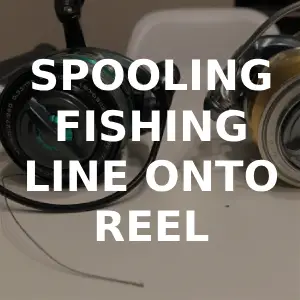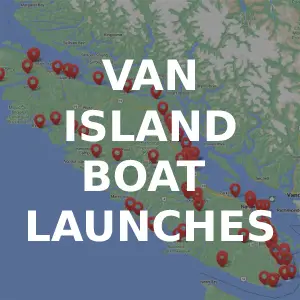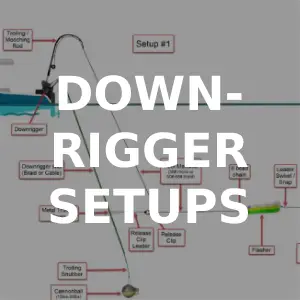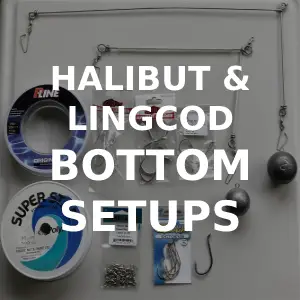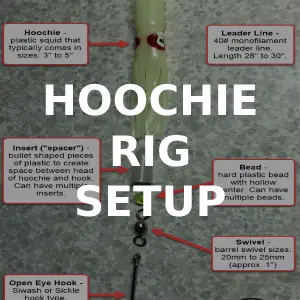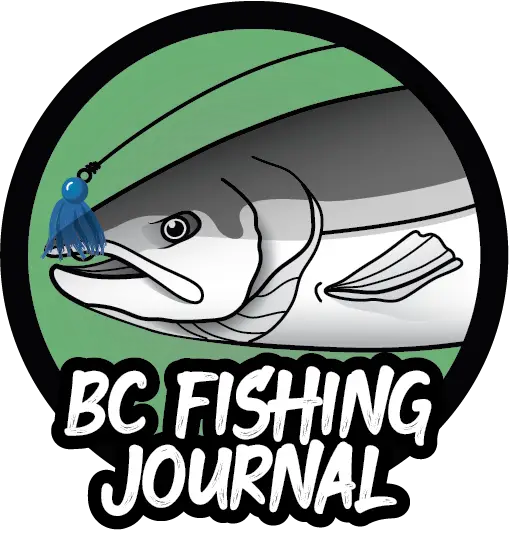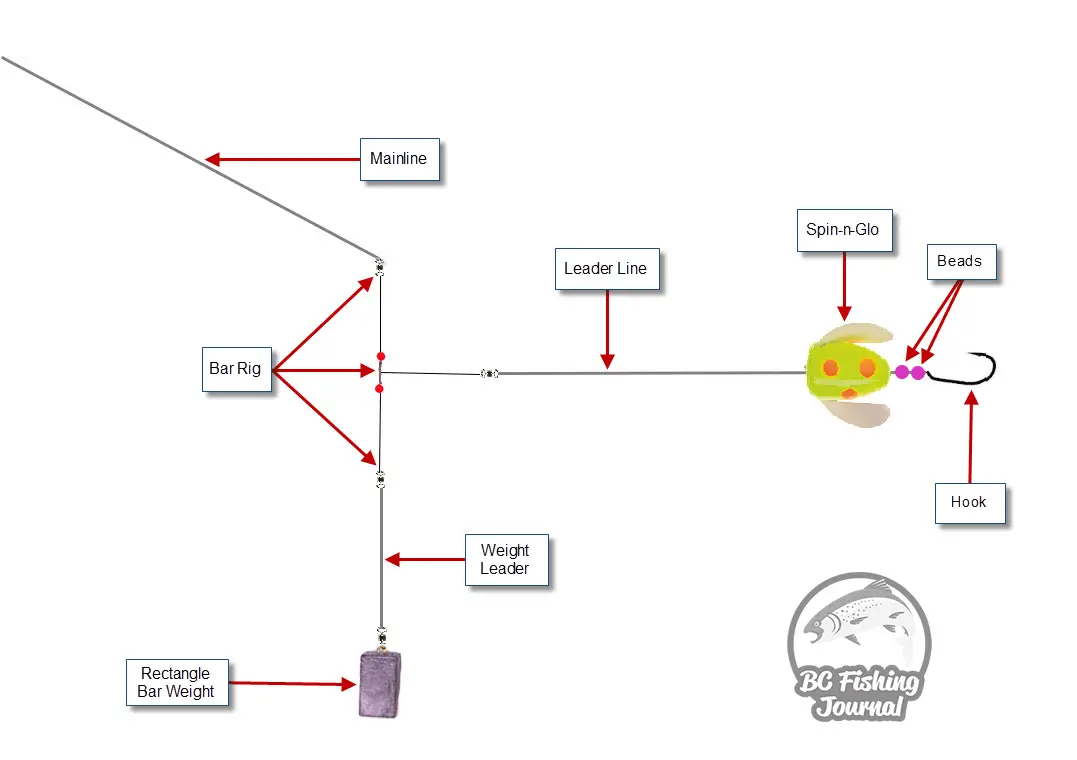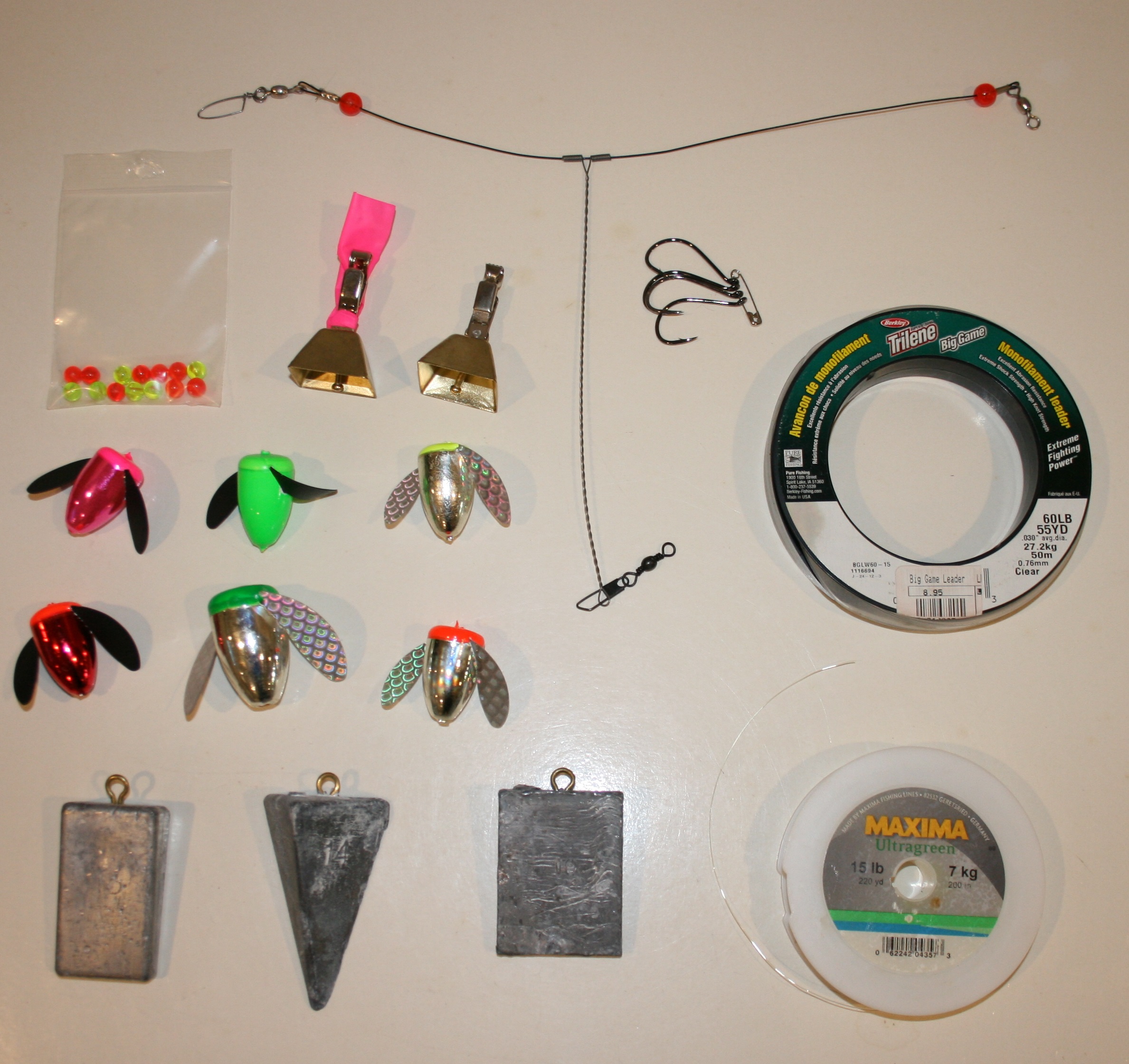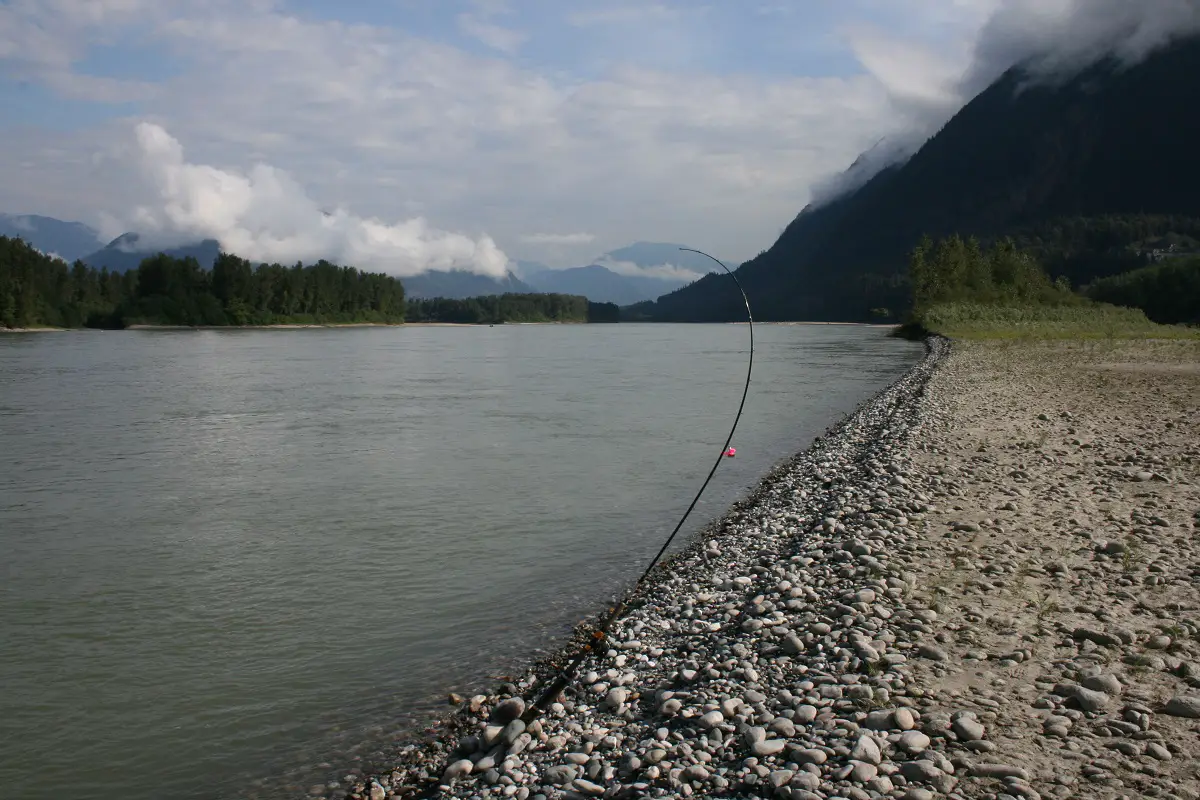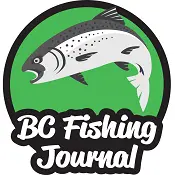Fishing with a Bar Rig Setup
Bar fishing is a great technique to use on larger rivers where you’re essentially bottom fishing from shore. The setup enables you to post a spin-n-glo or chunk of bait (usually roe) in the fish lanes by holding the rig down with a large weight. This setup is particularly popular in the Pacific Northwest for Chinook (King) Salmon on the big rivers like the Skeena, Fraser, Columbia, etc.
Diagram of a Bar Rig Setup
The diagram below outlines a typical bar rig setup. Full specification details are included below the diagram.
How to Setup a Bar Rig: Tackle
Mainline
- 80# – 100# braided line would be my top choice (braid has a thinner diameter so less drag on the setup)
- If you prefer monofilament you should be using 24# – 30# line.
Bar Rig (Spreader Bar)
- This is a T-shaped wire spreader bar that has beads and snap swivels attached.
- The purpose is to prevent your leader and weight from tangling.
- This rig acts as the connecting piece for the mainline, leader line and the weight leader (or weight).
Leader Line
- 40# – 60# monofilament leader line, you could also use fluorocarbon but it has less stretch (less give), which is preference thing.
- 24″ – 36″ long leader
Spin-N-Glo
- Sizes 2 – 0
- Match the size of the spin-n-glo to the size of the hook:
- Hook size 3/0 – 5/0 for spin-n-glo size 2
- Hook size 5/0 – 7/0 for spin-n-glo size 0
Beads
- Use 2 or 3 beads (plastic bulk beads)
- Size 8 beads or smaller
- Color isn’t as important but experiment
- TIP! The purpose of the beads is to create space between the spin-n-glo and the hook, this will provide better hook ups when the fish bites the spin-n-glo.
Hook
- Sizes should align to the size of the Spin-N-Glo (see Spin-N-Glo above)
- Sizes can range from 3/0 – 7/0, if you have to pick one hook go in the middle with 5/0
- Knots: Tie a Snell knot for Spin-n-glo, you can also try to tie an Egg loop knot when using bait but this may be challenging based on the size of leader line you’re using.
Weight Leader
- It’s a very short leader that connects the weight to the bar rig spreader. This is optional as you can choose to connect your weight directly to the bar rig.
- 15# monofilament line
- 4″ – 6″ long leader (length dictates how high you want your spin-n-glo to be in the water column)
- Having a lighter weighted leader line is very important as this line is fine to break off when fighting a fish (lose the weight)
Weight
- Weights often range from 12oz – 22oz.
- The weight is dictated by water current, for faster water you’ll need a heavier weight, and lighter for slower water.
- TIP! Use as little weight as possible but at the same time ensuring your rig is staying directly in front of you and not sliding down the river.
Additional Tackle and Gear
Rod
- 10’6 – 12′ rods
- Ensure the weight rating can handle 25# line (mono)
- A heavier rated rod with a strong backbone is important to handle these large Chinook (King) Salmon
Reel
- Need a larger reel with lots of line capacity (220+ yards of line)
- Heavy duty reel as it needs to handle casting the 12 oz to 22 oz weights
Bell
- Your audible indicator! Attach the bell to your 3rd or 4th eye from the reel (connector should come with bell).
- Add a piece of bright 6″ ribbon to the bell in case it falls in the water (so you can find it).
Salmon Net
- Super important to land the fish. You greatly reduce the risk of loosing a fish in having one of these nets.
- You’ll need a large sized net for the big Chinooks
Rod Holder
- There are various styles of rod holders, rebar, metal, aluminum, etc. You can make your own with 5/8 rebar and 2″ tube.
- Ensure your rod holder is at least 3 feet high. This reduces the amount of line on the water (less drag on the rig).
Where to Fish a Bar Rig
The best bars to fish are gravel bars that have a gentle taper. Think about what lanes the fish would be taking up the river, consider the depth and current speed. For Chinook Salmon you’ll want to fish in water between 4 – 8 feet deep.
When you’re casting your rig out, cast upriver as the weight and setup will often slide a little before settling. The weight should hold the bar rig directly in front of you off the beach. This also ensure’s you’re not taking up additional space on the bar if there’s multiple anglers around. On this note of fishing with other anglers, ensure you have 40′ – 50′ between each rod.
Water Visibility for Bar Fishing
One of the most important factors for bar fishing is knowing the water clarity. When visibility is less than 10″ it’s almost impossible for the fish to see your spin-n-glo unless he runs right into it. Water clarity is impacted by a number of things, big ones being the yearly snow pack (and freshet), mud slides or runoff’s, etc. A lower snow pack will often bring clearer water conditions earlier in the summer (approx. June), and a heavier snow pack may not clear until August.
Few quick pointers on water clarity:
- Less than 10″ visibility is not very fishable (use bait if permitted)
- 10″ – 16″ visibility is fishable
- 16″ – 24″ visibility is really good, and of course anything clearer than this is fantastic.
Best time for Chinook Bar Fishing on the Fraser River
The best time to bar fish for Chinooks on the Fraser River is the end of July to early September. During this time you’ll be targeting the late summer Chinook run. Of course fish run times can change each year so this timing is not static. There are also other Chinooks running concurrently like the Harrison which usually starts at the end of August and goes until early October. Consider all these things with the water clarity and you should be in for a successful day on the bar.
Additional Tips
